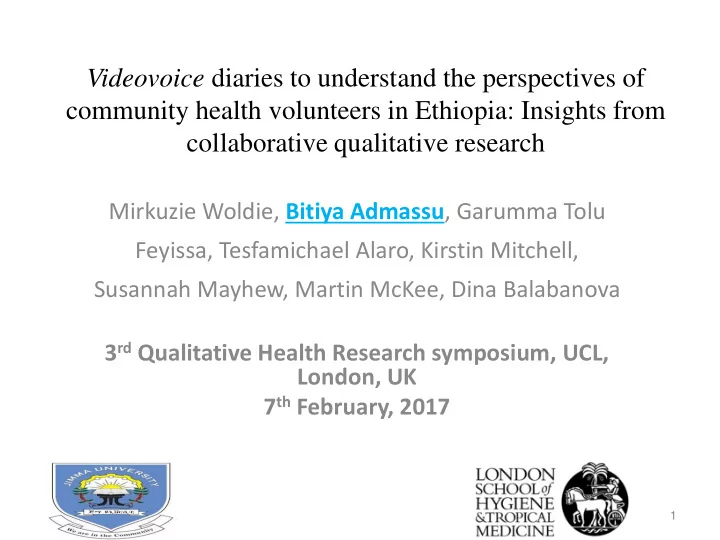

Videovoice diaries to understand the perspectives of community health volunteers in Ethiopia: Insights from collaborative qualitative research Mirkuzie Woldie, Bitiya Admassu , Garumma Tolu Feyissa, Tesfamichael Alaro, Kirstin Mitchell, Susannah Mayhew, Martin McKee, Dina Balabanova 3 rd Qualitative Health Research symposium, UCL, London, UK 7 th February, 2017 3/7/2017 1
Outline Background Objective Methods Discussion 3/7/2017 2
Background A video diary is a digitized diary used for the collection of data on informants’ lives over an extended period. Is an established social science method It has more recently gained importance in the field of health policy and systems research (Jewitt C, 2012). 3/7/2017 3
Background… • Advantage of the method a) participant-led and authentic in reflecting unique individual experiences; view b) capture experiences in real time , thereby minimizing recall bias c) reflexive, stimulating the maturation of respondents’ ideas over time d) motivate and empower respondents 3/7/2017 4
Objective • General objective: To understand the role of community health volunteers as mediators of accessible and responsive PHC in Ethiopia. • Specific objective: To understand perspective of community health volunteers To explore community health volunteers lived experience 3/7/2017 5
Methods Study setting: Three district of Jimma Zone, Oromia regional state • Seka Chekorsa (Best performing district) • Tiro Afeta (Medium performing district ) • Omo Nada (Least performing district ) 3/7/2017 6
Methods… Design: Qualitative study Collaborator: researchers, community and health managers Participant were selected purposively based on performance in implementing WDA program Ethical clearance: IRB of JU, LSHTM and Oromia Regional Health Bureau 3/7/2017 7
Method… Procedure • Conversation to create rapport and trust • Informing the purpose and procedure • Training on how to use and record the mobile phone • Encrypted phone with recording capability given • Regular contact and communication by researchers – To establish trust, support and reduce social desirability 3/7/2017 8
Method… Data security Training on the use of pass words • Simple pass words/pattern • To call to one of the research team in case they face any difficulty • Avoid consulting others for technical support • The data taken only with secured USB 3/7/2017 9
Method… Analysis • Footage will be obtained from 30 WDA, over 3-4 months. • The videos and audios will be transcribed using multimodal transcription methods (gestures, sounds) (Taylor C J. (2003). • The transcription will be analysed and triangulated with the data obtained via indepth interview, FGD and record analysis. • The videos and qualitative data will be analysed and compared using ATLASti 3/7/2017 10
Method… Analysis • A co-production workshop with participants and researchers to interpret the findings will be held. – Key themes, priorities and interpreting the event 1. Developing guiding questions • Video records will be analysed along with key insights gained from data gathered from other techniques • However, We will allow flexibility and explore new phenomena that were not discovered through other methods, but are participant-generated. 3/7/2017 11
Method… Analysis 2. Developing content log a description of major events that took place for each brief standard unit of time WDA meetings, Coffee ceremonies, other community events 3. Viewing and re-viewing the videos Individually and in group (participant groups, research teams) and comparing interpretation Collaboration has considerable benefits and challenges. 3/7/2017 12
Advantage • Videovoice is a self-directed method shifting power to the participants: – They determine what to capture, – What is important and – How to convey their views and activities and – How to communicate with the researchers Participants were quick to pinpoint their practice and daily life- become a reseacher 3/7/2017 13
Advantage… Steep learning curve was seen They were given a phone for recording stimulated to regularly engage in the WDA activities • Data is enriched by participant-generated insights into the reasons behind their decisions. • A multi-disciplinary research team will enhance the analytical process and interpretation. 3/7/2017 14
Motivation 3/7/2017 15
Disadvantage • They may record what is relevant to them – but not help to inform policy change • Technical difficulties; – lack of consistent electricity, – soundless record – difficulties finding phones that allow for secure collection of footage • Recording of artificial or unnatural events organized just for the sake of recording 3/7/2017 16
disadvantage… The footage may be affected with lack of good rapport and trust, with the researchers and the local community The co-production workshops is critically dependent on effective communication and trust. 3/7/2017 17
Discussion • Videovoice can be a useful tool in enabling lay researchers • To describe their daily life and understand their needs • To identify mechanisms for change. • To stimulate the maturation of respondents ’ idea overtime • To accurately document challenges and opportunity for implementing WDA system in their cultural context (‘dabo’, ‘iddir’) 3/7/2017 18
Discussion… • It can be used as a complimentary with other methods • It helps to interpret qualitative findings • To validate interpretation of data generated via other methods 3/7/2017 19
Discussion… • The approach can strengthen the immediacy of the research, capturing perceptions within context. • Co-production will involve a significant shift in power and emergence of new directions. • It equips participants with skills to re-examine their reality. 3/7/2017 20
Selected References • Jewit, C. (2012). An introduction to using video for research. • Taylor, C. J. (2003). Multimodal transcription in the analysis, translation and subtitling of Italian films. The translator , 9 (2), 191-205. 3/7/2017 21
Acknowledgments • MRC/Welcome Trust Joint Health Systems Research Initiatives • London School of Hygiene and Tropical Medicine • Jimma University • Jimma zone Health Office • Participants 3/7/2017 22
Recommend
More recommend